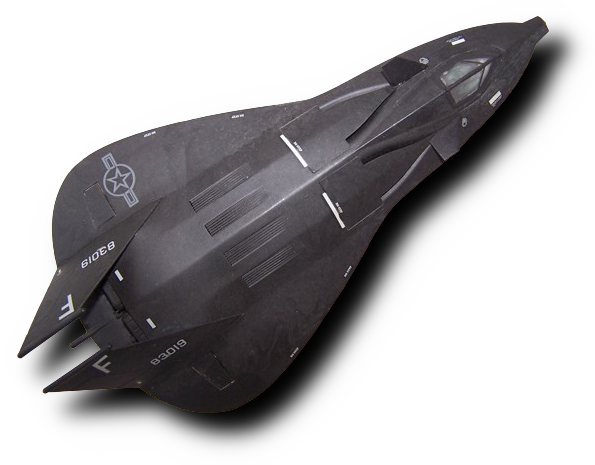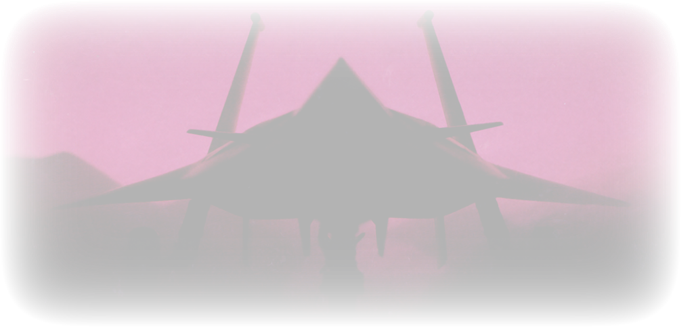




Born in the 80s, a child of the confusion around Lockheeds then-new
black project - the F-19 is the stealth fighter that never were. Its legendary
design was the work of model maker Testors, who at the time based
much of their intel on sources from within the defense industry. The result
was a sleek, rounded and quite futuristic aircraft that little resembled the
straight edged “wobbly goblin” F-117A that was revealed almost 3 years
later. Testors would have the public believe that Americas next secret
aircraft was a multirole fighter capable of air-to-air combat as well air-to-
ground operations. While there were other model makers doing variations
on the theme, leading to further confusion, Testors kit was the most
prominent shape of them all and a favorite of the public. In the eyes of
this writer, it is certainly the most stylish and pretty. It is a machine of
dreams, hence its nickname “Ghostrider”!
black project - the F-19 is the stealth fighter that never were. Its legendary
design was the work of model maker Testors, who at the time based
much of their intel on sources from within the defense industry. The result
was a sleek, rounded and quite futuristic aircraft that little resembled the
straight edged “wobbly goblin” F-117A that was revealed almost 3 years
later. Testors would have the public believe that Americas next secret
aircraft was a multirole fighter capable of air-to-air combat as well air-to-
ground operations. While there were other model makers doing variations
on the theme, leading to further confusion, Testors kit was the most
prominent shape of them all and a favorite of the public. In the eyes of
this writer, it is certainly the most stylish and pretty. It is a machine of
dreams, hence its nickname “Ghostrider”!


The kit is said to be the best selling plastic model of all time, and the
expected aircraft was subsequently featured in news, media and in
books such as Tom Clancy’s 1986 novel “Red Storm Rising”. There it had
expected aircraft was subsequently featured in news, media and in
books such as Tom Clancy’s 1986 novel “Red Storm Rising”. There it had
a whole storyline devoted to its use and it is quite the exciting ride!
As fate would have it, MicroProse picked up on this and decided to
develop a simulation, that was to be published for Commodore 64 and
later for the ZX Spectrum. The game was called “Project Stealth Fighter”
and was designed by Jim Synoski and Arnold Hendrick. It was a fine
simulation for its time, with groundbreaking AI and comprehensive
scenarios. Project Stealth Fighter deserves an article of its own, and there
will probably be one in the future. In my humble view, there are several
aspect of the game that should have been preserved better in later
games, like the excellent, high tech, -yet dark and serious atmosphere it
sets. The bottom line is that the limitations of the C64 were skillfully
navigated by MicroProse, to produce probably THE best 8-bit combat
flight simulator of all time.
develop a simulation, that was to be published for Commodore 64 and
later for the ZX Spectrum. The game was called “Project Stealth Fighter”
and was designed by Jim Synoski and Arnold Hendrick. It was a fine
simulation for its time, with groundbreaking AI and comprehensive
scenarios. Project Stealth Fighter deserves an article of its own, and there
will probably be one in the future. In my humble view, there are several
aspect of the game that should have been preserved better in later
games, like the excellent, high tech, -yet dark and serious atmosphere it
sets. The bottom line is that the limitations of the C64 were skillfully
navigated by MicroProse, to produce probably THE best 8-bit combat
flight simulator of all time.
Two years later, MicroProse releases “F-19 Stealth Fighter” for MS-DOS. At
the time flight simulators had started cluttering the market, but Bill Stealey
and Sid Meier firmly believed in a really good game being sellable
nonetheless. With lead design by Sid Meier, and programming by Andy
Hollis, Jim Synoski and Meier -the game was a departure from Project
Stealth Fighter in all areas except for the scenario concepts, scope and
the hardware / weapons depicted ingame. F-19 Stealth Fighter loaded
quick, ran faster, had high polygon complexity, better resolution and
more features compared to its predecessor. Now there were out-of-
cockpit camera views, better MFD capabilities, more detailed cockpit
and scenery. Meier did his best to base the aircraft specs on available
data, and to make the best and most enjoyable simulation possible for
the time. Judging from the amount of awards and reviews the game got,
one might say he and the MicroProse team succeeded in their targets.
the time flight simulators had started cluttering the market, but Bill Stealey
and Sid Meier firmly believed in a really good game being sellable
nonetheless. With lead design by Sid Meier, and programming by Andy
Hollis, Jim Synoski and Meier -the game was a departure from Project
Stealth Fighter in all areas except for the scenario concepts, scope and
the hardware / weapons depicted ingame. F-19 Stealth Fighter loaded
quick, ran faster, had high polygon complexity, better resolution and
more features compared to its predecessor. Now there were out-of-
cockpit camera views, better MFD capabilities, more detailed cockpit
and scenery. Meier did his best to base the aircraft specs on available
data, and to make the best and most enjoyable simulation possible for
the time. Judging from the amount of awards and reviews the game got,
one might say he and the MicroProse team succeeded in their targets.




F-19 Stealth Fighter was released on a total of 4 platforms, the first being
for IBM-PC compatibles in 1988, then on Amiga and Atari ST in 1990, and
finally for the Japanese PC-98 in 1992. The word is that the US “Office of
Assistant Secretary of Defense” released its first confirmation of the F-117s
existance on the very same day MicroProse released F-19 Stealth Fighter.
However, this cannot be correct as the official statement came on
November 10th, 1988, and the first version of F-19 (version 435.00) was
released on October 14th 1988. Instead, the date of November 10th
matches the release date of version 435.02 of F-19. This writer assumes
that this myth must have been hyped up a bit later, for whatever reason.
In any case, it did upset the validity of the game a bit, as the real
Skunkworks’ angular and alien design of the F-117A could not have
deviated more from the smooth lines of the Testors plane. Seeking to give
players a representation of the F-117A, MicroProse included a model of
for IBM-PC compatibles in 1988, then on Amiga and Atari ST in 1990, and
finally for the Japanese PC-98 in 1992. The word is that the US “Office of
Assistant Secretary of Defense” released its first confirmation of the F-117s
existance on the very same day MicroProse released F-19 Stealth Fighter.
However, this cannot be correct as the official statement came on
November 10th, 1988, and the first version of F-19 (version 435.00) was
released on October 14th 1988. Instead, the date of November 10th
matches the release date of version 435.02 of F-19. This writer assumes
that this myth must have been hyped up a bit later, for whatever reason.
In any case, it did upset the validity of the game a bit, as the real
Skunkworks’ angular and alien design of the F-117A could not have
deviated more from the smooth lines of the Testors plane. Seeking to give
players a representation of the F-117A, MicroProse included a model of
it in the last F-19 release, version 435.04. The player could choose to
overwrite the old F-19 model with the new F-117A. But since the new
model was based only on the first vague photo released of the jet (later
admitted to be disinformation put out by the Air Force) it had quite the
wrong proportions and did not look very good ingame. One could argue
F-19 Stealth Fighter should remain in its own bubble, as the simulation of a
reality that never came to be. Did I mention the F-19 looks awesome?
overwrite the old F-19 model with the new F-117A. But since the new
model was based only on the first vague photo released of the jet (later
admitted to be disinformation put out by the Air Force) it had quite the
wrong proportions and did not look very good ingame. One could argue
F-19 Stealth Fighter should remain in its own bubble, as the simulation of a
reality that never came to be. Did I mention the F-19 looks awesome?
In any case, the real F-117A would soon get its own dedicated simulation
in 1991, by none other than MicroProse. But that is for another page to
cover. The original PC version of F-19 came packed with a substantial
manual of the kind only provided by MicroProse, packed with loads of
data on the scenarios, the weapons, friendly and enemy planes and so
on. The box also included 4 maps of the operation areas -Libya, Persian
Gulf, The North Cape and Central Europe. These could be considered
hot-spots of the Cold War. As was becoming the norm for MicroProse sims,
you also had a couple of large keyboard overlays for easy reference
during flight for systems operation. And in F-19 the systems were deeper
than before, so you do really need to have that key reference handy.
in 1991, by none other than MicroProse. But that is for another page to
cover. The original PC version of F-19 came packed with a substantial
manual of the kind only provided by MicroProse, packed with loads of
data on the scenarios, the weapons, friendly and enemy planes and so
on. The box also included 4 maps of the operation areas -Libya, Persian
Gulf, The North Cape and Central Europe. These could be considered
hot-spots of the Cold War. As was becoming the norm for MicroProse sims,
you also had a couple of large keyboard overlays for easy reference
during flight for systems operation. And in F-19 the systems were deeper
than before, so you do really need to have that key reference handy.

Unless you consult the manual you will need to know your planes, as the
game’s copy protection is based on aircraft recognition -though it is not
too difficult. As a flight simulator, F-19 might be a bit rigid by modern
standards, the flight model is forgiving but considering it was meant to be
keyboard friendly and fun, it is completely satisfactory for a DOS sim. The
gameplay is fast, thrilling, and you will feel the pressure to stay un-
detected as you weave your way through the gauntlet of radars and
SAM sites. The presence of enemy aircraft is always threatening to detect
you. The gameplay is firmly based on staying hidden and unlike the real
F-117A that turned out to be more stealthy than assumed, the F-19 is in
fact harder to conceal. This makes for a more exciting sim, and
combined with the air-to-air capability you will have your hands full. To
take out your targets successfully, you will also have to select the proper
weapons for the job, and there will sometimes be non-standard missions
such as equipment-drops within a certain timeframe or photo
reconnaissance. While you will be given a flight route in the briefing, it
game’s copy protection is based on aircraft recognition -though it is not
too difficult. As a flight simulator, F-19 might be a bit rigid by modern
standards, the flight model is forgiving but considering it was meant to be
keyboard friendly and fun, it is completely satisfactory for a DOS sim. The
gameplay is fast, thrilling, and you will feel the pressure to stay un-
detected as you weave your way through the gauntlet of radars and
SAM sites. The presence of enemy aircraft is always threatening to detect
you. The gameplay is firmly based on staying hidden and unlike the real
F-117A that turned out to be more stealthy than assumed, the F-19 is in
fact harder to conceal. This makes for a more exciting sim, and
combined with the air-to-air capability you will have your hands full. To
take out your targets successfully, you will also have to select the proper
weapons for the job, and there will sometimes be non-standard missions
such as equipment-drops within a certain timeframe or photo
reconnaissance. While you will be given a flight route in the briefing, it
will sometimes be necessary to change it in-flight to avoid unpredicted
air/ground threats. Low and slow is the name of the game here.
air/ground threats. Low and slow is the name of the game here.
The F-19 is well powered by its monstrous F-404 engines, and compared to
the F-117A it can absorb a lot more damage. It is a proper, capable,
stealthy combat aircraft, designed for a hot war. But get shot up over
enemy territory and you’ll have a long and lonely flight back to base!
the F-117A it can absorb a lot more damage. It is a proper, capable,
stealthy combat aircraft, designed for a hot war. But get shot up over
enemy territory and you’ll have a long and lonely flight back to base!
Useful Stuff:

PixelWings™ 2024
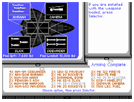

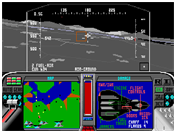
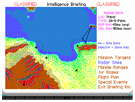
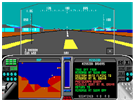
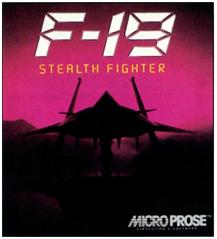
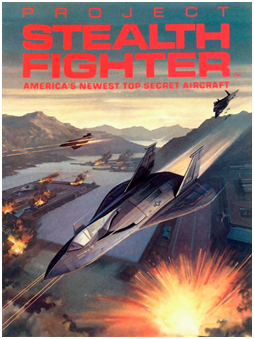
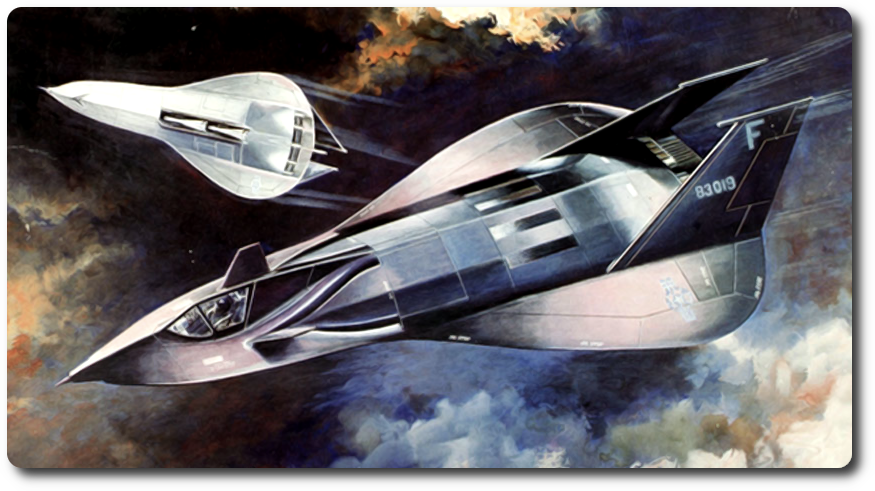
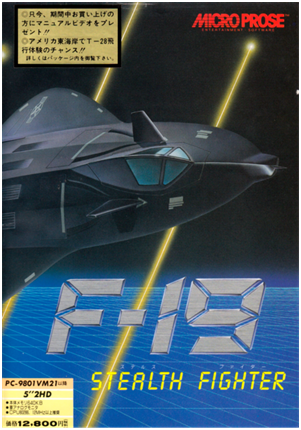
Interestingly, the box art for the
Japanese PC-98 release of F-19
featured a handdrawn aircraft,
spanning both front and back of the
box, in addition to a more stylized logo
and background. Overall it had a more
serious and dangerous atmosphere!
Japanese PC-98 release of F-19
featured a handdrawn aircraft,
spanning both front and back of the
box, in addition to a more stylized logo
and background. Overall it had a more
serious and dangerous atmosphere!
The iconic design of the F-19, as depicted on the Italeri box art.

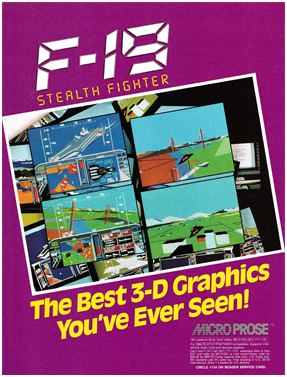
The game can run in both EGA 16-color
and VGA 256-color modes, but the only
thing VGA brings to the table are some
gradient corners in the cockpit.
and VGA 256-color modes, but the only
thing VGA brings to the table are some
gradient corners in the cockpit.

